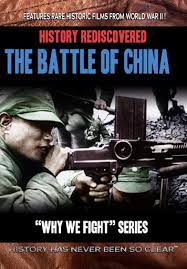
“Why We Fight: The Battle of China” is the sixth film in the Frank Capra “Why We Fight” propaganda film series. It was released in 1944 and was commissioned by the Office of War Information. This and the other six films were designed to give American service men inspiration before they were sent overseas. It is another example of how history is either remembered or designed based on who is telling it. The film makes the Chinese out to be a peace-loving simple people. Since, at the time, China was part of the Allies and Japan was part of the Axis Powers I would expect nothing less.
Hitler wanted to rule the West and purge it of anyone who was not part of his Arian ideal, Mussolini wanted gain back and rule what used to be the Roman Empire and Emperor Hirohito wanted to rule the East, including the South Pacific.
Japan began their four-phase quest for power by quietly invading the Chinese province of Manchuria. Japan’s grand plan was first to capture Manchuria. Once that was secured, they wanted to acquire China. Phase three was to secure bases in the South Pacific. From there they could go on to phase four, conquering the United States.
China also had a scorched earth policy when it came to giving up territory to Japan. According to the film, China was made up of several provinces that weren’t united until the Japanese began their attacks. The attack on Nanking served as a battle cry to instill in the Chinese a desire to take back their country and to keep Japan out.
The film includes graphic footage of the aftermath of the Rape of Nanking, the building of the Burma Road and mentions the attack on Pearl Harbor in Hawaii. Also referenced is Madame Chiang Kai-Shek’s address before congress, the Chinese 2,000-mile migration and a nod to the American Flying Tigers.
Australia also used this film for their armed services in their orientations. The object was to inform the Australians that what happened in China could have happen in Australia. The only difference between the original and the Australian version is an informational scroll at the end of the film.
Original film
Australian Version

